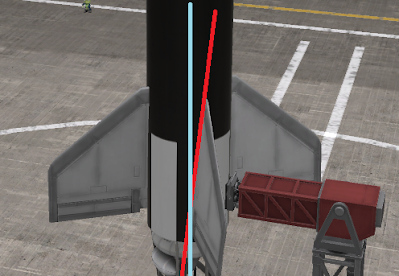You spin me right round, baby, right round, like a rocket baby
Project: SR-2 Sounding Rocket
Purpose: Demonstrate the ability to carry non-trivial payloads out of Earth atmosphere on sub-orbital missions
The most critical component of our SR-2 rocket which will distinguish it from the SR-1 is the much more powerful engine. The engine we're using for this rocket is equivalent to the RD-101, a derivative of the German V-2 rocket engine, capable of ~400Kn of thrust on launch as opposed to the ~7kN of the SR-1. No that is not a typo.
Historical Note: Both the USA and the USSR cloned and then improved upon the V-2 rocket engine design. The RD-101 was completed by the Soviet Glushko Bureau (OKG-456) with no German engineers involved, but based heavily on the V-2 design. The RD-101 would go on to be used in the R-2 short range ballistic missile (NATO Name: SS-2 Sibling). The R-2 rocket was originally considered for the first Russian manned sub-orbital flights, but this was skipped in favour of going straight in to orbit in the flight ultimately piloted by Yuri Gagarin. When the USSR eventually passed the aging R-2 design on to Communist China in the late 50s it would go on to form the backbone of the Chinese rocket program.
In principle the design of the SR-2 isn't far different from the SR-1, aside from being much bigger, but there are some key differences.
First of all, the engine relies on a hypergolic combination of Liquid Oxygen and Ethanol. Our new rocket is, in effect, a giant Molotov cocktail regulated to prevent it getting too much fuel at once.
Historical Note: The Soviet engineers, being Russian, made sure to siphon off unspent alcohol for 'recreational purposes'. The engines themselves were nicknamed the drunk engines. When the engine was used in the R-2 missile, however, the ethyl alcohol was replaced with methyl alcohol. Why? To stop the launch crews drinking the nuclear SRBM's fuel of course.
More critically for our design, the SR-2 is large and heavy enough that it can't maintain aerodynamic stability once the rocket thrust runs out in atmosphere. Without a force keeping the rocket pointing upwards it will tend to be pushed off course and ultimately suffer a rapid unscheduled disassembly. We need another mechanism to stabilise our rocket.
At this point, we do not the ability to produce gimballed rocket engines, nor would we have any means of controlling them remotely. We also don't have access to reaction wheels. Thus, we'll need to rely on a more primitive approach: Spin stabilisation.
By putting our rocket in to a 'controlled' spin "the gyroscopic action of the rotating spacecraft mass is [itself a] stabilizing mechanism" which self-corrects to keep the rocket on the planned trajectory.
Although it's a confusing concept to visualise, spin stabilisation is very easy to achieve. We simply take our existing stabilisation fins and tilt them slightly to one side, like so:
This will cause the rocket to spin in a consistent, controlled, manner (although it does look very much out of control to the casual observer!).
The RD-101 is rated for 80 seconds of burn and we're only planning on around 50s for now. Plus as it's single stage (for now), we also don't have to worry about ullage issues.
All this effort and scaling up is to allow the SR-2 to carry a sounding payload. By demonstrating we can take up sounding payloads of research experiments we prove out the principle that we are able to handle larger payloads like satellites, while also earning some funding. This will be a good source of funding in the short-term, since there's always some scientists who can find a use for a rocket.
This design can also be adapted for other sub-orbital challenges, such as proving out re-entry payloads.
Here's our 15 tonne design, ready to go:
The planned first launch date is 10th November 1951.
Next Post: Sounding Rocket 2, now with 200% more sounding




Comments
Post a Comment